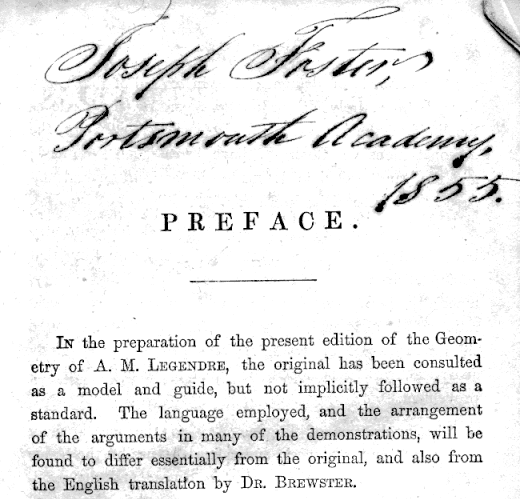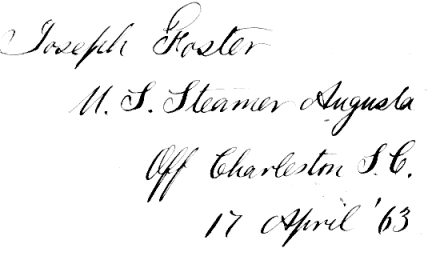"Legendre's" Math Text
Today, the owner of an old math book talks to us. The University of Houston's College of Engineering presents this series about the machines that make our civilization run, and the people whose ingenuity created them.
Few things delight any historian as much as being allowed to walk through the mirror into another life in another age. That happened to me the other day, quite by accident.
I have an old math text, published in 1855. I picked it up in some used bookstore. I can't remember where. The name Legendre is stamped on its calfskin cover. Legendre was a great French mathematician who died long before 1855. It turns out that the book is only loosely based on a Legendre textbook.
A New Hampshire schoolboy got the book when it was new. He inscribed it in a flowing young hand: "Joseph Foster, Portsmouth Academy, Sept., 1855."
Just yesterday, I spotted a second inscription, farther in. The same person wrote it, but the schoolboy flourish is gone. It says: "Joseph Foster, U.S. Steamer Augusta, off Charleston, S.C., 17 April, 1863." What a shock that was!
It meant that Foster had joined the Union Navy. He was part of the Charleston Blockade in the Civil War. He shipped on the Augusta, a steam-powered, paddle-driven Union gunboat. When we first sent steam off to war, we sent Foster with it.
Ten days before Foster inscribed his book the second time, the Augusta joined Admiral duPont's attack on Charleston. The attack failed miserably. The Union Navy retreated into the Bay and relieved duPont of his command.
Now Foster reaches across the years to tell me he was there -- that he saw men die. My old text on geometry and trigonometry was there with him. So I reached back to look for Foster. I caught up with him in a Portsmouth library.
He was 14 when he got his new book -- 22 during the defeat at Charleston. He shipped on two more steam gunboats during the War. His last boat sank while the Navy was towing it back to New York after the War. Only Foster saved any personal effects. All he saved were his books and papers. He saved my geometry book.
Thirty-seven years later, Rear Admiral Foster retired. He'd gone all the way through the Spanish American War, but no more combat. He was a supply officer. Back in Portsmouth, he ended his life writing histories and biographies. He died three months before I was born. His old school is now the City Library.
It's clear from Foster's marginal notes that he bogged down after plane geometry. Yet he carried this book through the War, and I think I know why. It was a young man's time out of war. It was a moment of retreat into a clean and beautiful place. My old book was a handhold on sanity -- in a world that'd lost its wits.
I'm John Lienhard, at the University of Houston, where we're interested in the way inventive minds work.
(Theme music)
Davies, C., Elements of Geometry and Trigonometry. from the Works of A.M. Legendre, Revised and Adapted to the Course of Mathematical Instruction in the United States, New York: A.S. Barnes & Co., 1855.
(It turns out that Davies did other textbooks using the names of famous people. See, e.g.; Davies, C., Elements of Algebra: in the Basis of M. Bourdon: Embracing Sturm's and Hormer's Theorems, and Practical Examples. New York: A. S. Barnes & Co. 1854.)
Gibbons, T., Warships and Naval Battles of the Civil War. New York: W.H. Smith Publishers, Inc., 1989.
I am most grateful to Caroline Eastman of the Portsmouth Athenaeum, 9 Market Square, Portsmouth, NH 03801, for her help in finding biographical material on Joseph Foster. Kathleen Gunning and Donna Hitchings at the UH Library located the trail that led to the Portsmouth Athenaeum. And my thanks to William Wallace of Houston for donating the Davies "Bourdon's Algegra" book.
Joseph Foster was born in 1841. During the Civil War, he shipped on three of the new Union gunboats. They were the Augusta, a 1310-ton sidewheel steamer; the Acacia, a 300-ton screw steamer; and the Commodore MacDonough , a 532-ton sidewheel ferry. The latter sank on August 23, 1865 as it was being towed from Port Royal to New York.
Foster continued in a variety of storekeeper and paymaster roles until he retired in 1902. He died on May 19th, 1930.

Foster's signature as a boy in prep school

Foster's signature as a Union naval officer during the siege of Charleston (both images from Elements of Geometry and Trigonometry from The Works of A. M. Legendre, 1855)